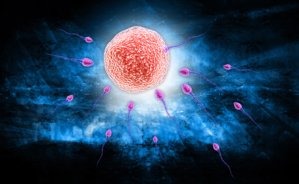Zinc fireworks reveal the quality of the egg and offer new hope for infertile couples
 Once the sperm cell has penetrated the egg cell, sparks fly from zinc atoms in a fascinating fireworks display. This new discovery may help fertility doctors select the most best eggs for in-vitro fertilization (IVF). The discovery also has relevance for all others who wish a successful pregnancy. It all boils down to having adequate zinc stores in the body.
Once the sperm cell has penetrated the egg cell, sparks fly from zinc atoms in a fascinating fireworks display. This new discovery may help fertility doctors select the most best eggs for in-vitro fertilization (IVF). The discovery also has relevance for all others who wish a successful pregnancy. It all boils down to having adequate zinc stores in the body.
Zinc is necessary for around 300 different enzymatic processes that control a number of functions in the body, including fertility and pregnancy. A team of researchers from Northwestern University of Chicago have come a long way in the understanding of what it is that creates a viable egg cell, but also the actual role of zinc. Their discovery may be of enormous importance, as there is a lot of evidence suggesting that zinc deficiencies may be an overlooked factor in infertility.
Zinc plays a crucial role in the making of new life
The Northwestern University researchers are the first in the world to uncover the magnificent fireworks display in the human egg cell and show exactly how the zinc molecules fly out like glowing embers right under the membrane of the egg cell. Right from the very first second, the zinc molecules have a crucial role in the biochemical processes that ensure that the fertilized egg divides and develops into an embryo and a fetus through different stages.
According to Dr. Teresa K. Woodruff, Ph.D, an expert in ovarian biology, the amount of zinc released by the egg cell may be a determining marker when fertility doctors have to single out the fertilized egg cells with the highest quality as part of the IVF therapy (in vitro fertilization). By identifying the egg cells that have the highest quality, it is possible to transfer fewer embryos to a woman's uterus during the treatment, and the chances of a successful pregnancy increase correspondingly.
Zinc is part of a comprehensive system inside the egg
The team of scientists developed several different methods to detect how much zinc an egg cell contains, and they also demonstrated where zinc is located in the egg cell during fertilization and the hours right after. Using technologically advanced and extremely sensitive equipment, the researchers were able to count each zinc atom inside the egg cell and observe the zinc sparks in three dimensions. That way, they discovered around 8,000 small "packages" below the cell membrane that each contained around one million zinc atoms. Right after fertilization, these 8,000 packages burst open, and in a split second the zinc atoms were shot out from the cell -exactly like fireworks. Right after, everything went quiet, until a second round of fireworks was dispatched. Altogether, each fertilized egg cell went through four of five violent rounds of zinc atom emissions.
Thomas V. O'Halloran from the research team described it as a spectacular sight. It was known from earlier research that large quantities of zinc were released from the egg cell, but nobody knew exactly what the whole process looked like. Now, they do.
The study shows how the egg cell allocates its zinc content, and how the zinc atoms are distributed so they are able to take part in the many enzymes that are necessary in order for a fertilized egg cell to develop into a healthy embryo. In many ways, zinc is essential for the creation of a whole new entity. The study is published in Nature Chemistry.
Zinc plays a crucial role in growth and developmentThis is because zinc is a part of the enzymes that help translate and express the genetic coding. |
Zinc deficiencies are common and may be caused by many factors
An estimated 25% of the world's population is zinc deficient, and this may be a contributing factor in infertility. Many things can cause zinc deficiencies such as unhealthy diets and lack of animal protein, which is normally a good source of zinc. Also, a large intake of iron, calcium, and alcohol may be involved. Excessive sweating, ageing processes, celiac disease (gluten intolerance), diarrhea, poorly managed diabetes, and other diseases may also cause a zinc deficiency. The same is the case with several types of medicine, ACE inhibitors, antacids, corticosteroids, antibiotics, and birth control pills.
Sources and supplements
Zinc is primarily found in oysters, liver, meat, shellfish, dairy products, nuts, seeds, kernels, and beans. Animal sources are absorbed the best. If a zinc deficiency is suspected, it is advisable to include several good zinc sources in the diet and possibly take a zinc supplement. It is also possible to determine zinc deficiency by means of a blood sample. If the doctor detects a deficiency, large quantities of zinc can be taken in the form of supplements.
References:
Science News: Radiant zinc fireworks reveal human egg quality. Science Daily 2016
https://www.sciencedaily.com/releases/2016/04/160426091734.htm
Science News: Stunning zinc fireworks when egg meets sperm. Science Daily
https://www.sciencedaily.com/releases/2014/12/141215114546.htm
http://www.netdoktor.dk/vitaminer/zink.htm
Search for more information...
- Created on .








